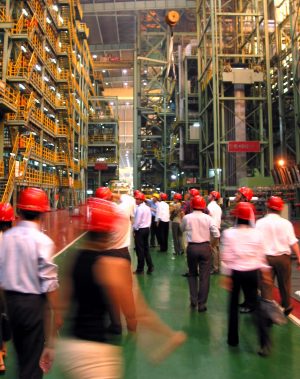“Cut carbon emissions or cut production.”
That’s the stark warning authorities in China’s steel production capital of Tangshan city in Hebei province issued last month to 23 local steelmakers, backed by a directive to restrict their operations until December 31, 2021.
The order reflects the official impatience with a spell of noxious industrial smog linked to those factories. But it dovetails with Chinese President Xi Jinping’s September 2020 commitment that China would act decisively to reduce its carbon emissions in order to reach carbon neutral status by 2060. Xi described that carbon neutrality goal for China, the world’s largest carbon emitting country, as necessary “to protect the Earth.” The United Nations’ Intergovernmental Panel on Climate Change has warned that carbon reductions are essential to limit global warming to 1.5 degrees Celsius by 2050, and that failure to meet that target will greatly increase “climate-related risks to health, livelihoods, food security, water supply, human security, and economic growth.”
But China’s status as the world’s largest steel producer renders Tangshan’s targeted, time-restricted shutdowns inadequate to address the sector’s massive carbon emissions. China’s steel sector contributes a whopping 15 percent of the country’s total emissions and constitutes 60 percent of global steel sector carbon emissions. Substantive reductions in carbon emissions require China’s government to help wean its steel sector from the heavily polluting blast furnaces that dominate the industry to low-carbon and carbon neutral production methods . The options range from adopting cleaner-burning electric arc furnaces to applying carbon-neutral new technologies fueled by renewable hydrogen or electrolysis.
China’s state-owned steel giants indicate they are ready for that transition. The country’s largest steel-maker, China Baowu Steel Group, announced in January that it will reach carbon neutrality by 2050. Chinese state-owned steelmaker HBIS last month unveiled similar decarbonization plans, indicating growing corporate buy-in on Xi’s official carbon neutrality target and timetable. That’s encouraging. But the costs of transitioning China’s steel sector production facilities to carbon neutral status will require a magnitude of investment beyond the capacity of even the country’s best-resourced state firms.
The energy consultancy Wood Mackenzie estimated in October 2020 that Xi’s national carbon neutrality target would require cross-sectoral investment of up to $5 trillion. Rival South Korean steel giant POSCO last month underscored the financial challenge of steel firms in making that transition when it revealed that replacement of its nine existing high carbon emission blast furnaces with carbon-neutral facilities will cost the “equivalent to its 30-year operating profit.” That means that China’s steel sector decarbonization will require meaningful government involvement through funding backed by supportive policy and regulatory initiatives.
Chinese policymakers can look for inspiration to a new international multistakeholder policy tool dedicated to accelerating and scaling-up the decarbonization of heavy industry to align with a 1.5-degree Celsius global warming trajectory. The Global Framework Principles for Decarbonizing Heavy Industry (“Framework Principles”) outline the role of government and private industry to ensure the successful decarbonization of heavy industries including steel, cement and chemicals through allocation of public financing for emissions reduction plans. The Framework Principles specify investment in low- and zero-carbon technologies as a top government and corporate priority to help phase out fossil fuel use in industrial processes.
The Chinese government conveniently has a ready mechanism to allocate such funding – tapping the more than $13.8 trillion in assets held by the “big four” state-owned commercial banks. The Chinese government has long channeled the massive financial resources of Industrial and Commercial Bank of China, Agricultural Bank of China, China Construction Bank and Bank of China for policy purposes. They include state-directed funding for economic stimulus initiatives, to help underwrite overseas infrastructure initiatives linked to China’s Belt and Road initiative and most recently to counteract the domestic economic impact of the coronavirus pandemic’s economic impact. The government could demonstrate it’s serious about decarbonization by also deploying state-owned China Development Bank (CDB) and its $3.2 trillion in assets to help fund the steel sector’s transition to carbon neutral status. The CDB already has a proven track record in providing essential seed funding to China’s now wildly successful solar power industry. That gives Chinese policymakers both the funds and the template to channel necessary funding for heavy industry sector decarbonization.
Such funding would dovetail both with President Xi’s carbon neutrality goal as well as the intentions of the government’s official 2016 Guidelines for “Establishing the Green Financial System.” But diverting the formidable reserves of China’s state bank sector to industrial decarbonization investment will also require explicit directives from the People’s Bank of China (PBOC), the country’s central bank, that specify an official green light for funding for carbon neutral projects. Such directives may be imminent. The PBOC announced on March 25 that it planned to create “carbon emissions reduction support tools” along with guidance to allow Chinese banks to increase support for initiatives that “reduce carbon emissions in accordance with market principles.” It should back that rhetoric with specific directives for state bank funding for heavy industry decarbonization.
President Xi Jinping bolstered his September 2020 carbon neutrality pledge with a call for a “scientific and technological revolution and industrial transformation” to achieve a “green recovery of the world economy in the post-COVID era.” He should now marshal the financial resources and policy mechanisms at his government’s command to make industrial decarbonization – starting with the steel sector – a top government priority.

































